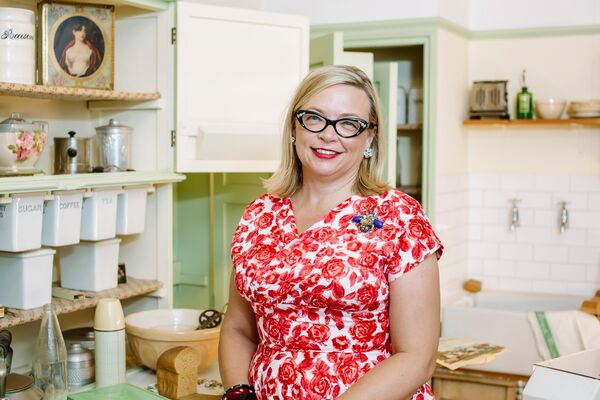
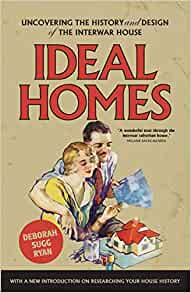
In my book Ideal homes: Uncovering the history and design of the interwar home you will meet two families who were the first occupants of newly built, modest interwar houses, documented in MoDA’s collections.
I chose these examples to be indicative of typical examples of interwar homeowners, with particular attention paid to their social mobility and aspirations, and women’s experiences. For each of them, doing a family tree proved invaluable, using the tools and records available from a digital genealogy provider.
The release of the 1921 Census of England and Wales on 6 January 2022 by the National Archives with family history website Findmypast gives me the opportunity to delve further into the lives of the first-time interwar homeowners that I discuss. Census records are very useful for finding out about the history of residents of houses. It is possible to search by address as well as by people’s names.
At the time I wrote the first edition of my book, the most recent census available was 1911. I found it an invaluable resource for tracing the family histories of my case studies. It allowed me to pin down their class backgrounds by looking at their parents’ occupations and addresses to help me tell the story of their social mobility and aspirations.
What new details does the 1921 Census reveal?
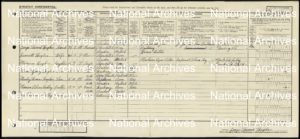
extract from the 1921 Census, courtesy of The National Archives
The newly released 1921 Census was taken on the 19 June 1921 at a time when the population for England and Wales was over 37 million. It gives greater detail than any previous census. In addition to the questions asked in the 1911 Census, the 1921 Census includes more information about occupations. Each occupation coded and a job description can be accessed in A dictionary of occupational terms based on the classification of occupations used in the census of population, 1921 (HMSO, 1927.)
The census also includes the employer’s name and address. For those over the age of fifteen, information about marital status (including if divorced) was given. For those under fifteen, the census recorded whether both parents were alive or if either or both parents had died. It also had detailed questions on education including whether individuals were in full-time or part-time education.
Crucially for house history, the 1921 Census lists separate households at the same address and lists the number of rooms they occupied. This detail reveals the working-classes living in overcrowded conditions in contrast to the middle classes had enough space to allocate different functions to rooms.
The census taken in 1931 was destroyed during the Second World War and no census was carried out in 1941 due to the on-going conflict. This means that there will not be another release until the 1951 census in 2052. However, the 1939 Register (of England and Wales), taken at the outbreak of the Second World War, was released in 2015 and I wrote about it in the new introduction to the second edition of my book. The 1921 Census fills the gaps between what I know about my case studies between 1911 and 1939.
The story of the Kinghams
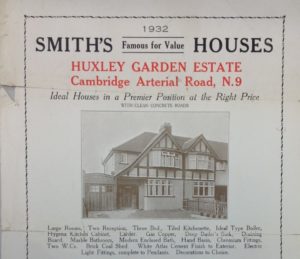
detail from house builder’s brochure, 1932, Badda4313
In chapter two of my book Ideal homes: Uncovering the history and design of the interwar home I tell the story of Ronald Kingham (age 28), a linoleum layer, and his wife Miriam (nee Hughes, 28). They purchased 23 Bromley Road in Edmonton, Middlesex, in 1932.
Their house purchase is documented in a file in MoDA’s collections, which shows that it had three bedrooms, two reception rooms, a small kitchenette and an upstairs bathroom.
The 1921 Census reveals that Ronald, then aged 16, was living at 24 South Road, Edmonton, in a small Victorian terraced house comprising two reception rooms and three bedrooms. He’s living with his father William (45), who like in the 1911 Census is working as a builder, his mother Sarah (43) and brothers William (18), Frank (13) and Edward (11).
The family finances must have been helped enormously by the wages of the two older boys. Ronald is working as a shop assistant at Dale & Sons, Home Furnisher on The Green in Lower Edmonton. This seems like a first step into his later occupation as a linoleum layer. William is working as an electrician’s mate for a firm of builders and decorators. Both brothers have made very different choices to their father, which may have brought them aspirations for a higher standard of living than their parents, aided by the insights into other people’s homes that their jobs gave them.
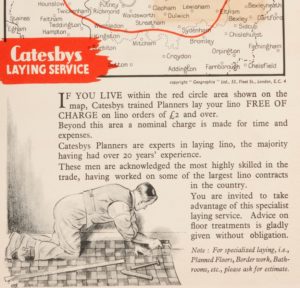
detail from Catesby’s linoleum catalogue, 1938, Badda181
Ronald’s future wife Miriam, aged 16, is living at home with her family in the same five-roomed terraced house – 28 Millfield Road, Edmonton – as they were in the 1911 Census but in considerably more overcrowded circumstances. The family has now expanded from two adults and two young children to seven in total. The household comprises her father George (39), a hardwood joiner, mother Harriet (40), brothers Edward (13) and Stanley (5) and two orphaned foster children, Marion (13) and Ivy Radley (5).
I haven’t been able to establish whether the foster children were related to the Hughes family or the cause of their parents’ death. Perhaps they were orphaned due to the recent influenza epidemic? Harriet is described as having “home duties” but she may have received payment for fostering.
A contemporary postcard, c. 1906, gives a further idea of what conditions in the house might have been like, depicting a view of Millfield Road with small Victorian terraced houses. Given that segregation of children by sex was the ideal, it seems likely that Miriam shared a bedroom with the two younger foster girls, which she might have found difficult as a young working woman. Investigation in historic and contemporary maps shows the road no longer exists, having been demolished and replaced with a school.
The 1921 Census reveals unexpected details
We might have expected a young woman like Miriam to have been in domestic service. But the census shows that she is working as a “machine cigar roller” at the Imperial Tobacco Company at their York Road factory. The Dictionary of Occupational Terms explains what this work would have involved: “cuts wrapper of cigar from leaves, rolls it round bunch, made by bunch maker q.v., and finishes point by sticking with gum tragacanth”. Factory work was often more attractive to young women like Miriam than domestic service, offering reasonable wages, better hours and companionship.
After marrying in 1928, Miriam and Ronald lived at 22 South Road in Lower Edmonton, next door to his parents. When they took out a mortgage four years later, ownership of their own home must have been a real contrast to their more crowded home lives and an aspirational step up from renting. This is brought home in the 1939 Register when Miriam is recorded visiting her widowed mother Harriet in a tiny house in Hemel Hempstead. Harriet is working as a charwoman and living with her widowed, retired brother-in-law and his married daughter. This suggests that Harriet, in contrast to Miriam, has slid down the social scale.